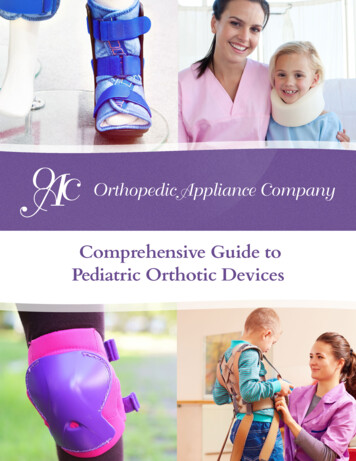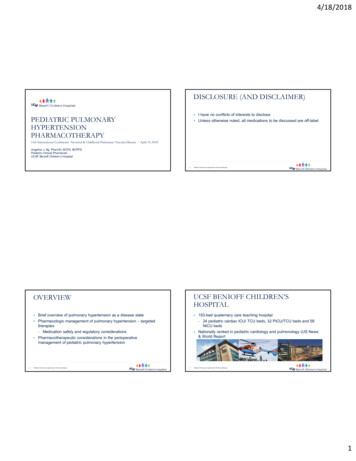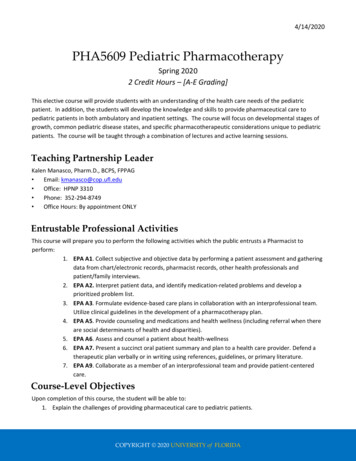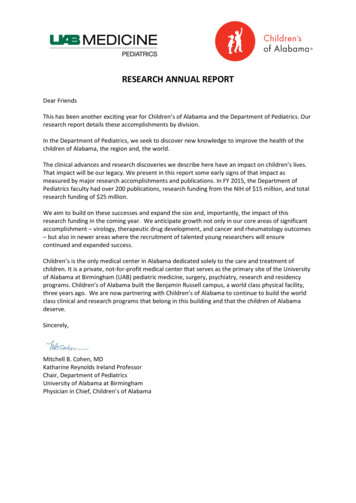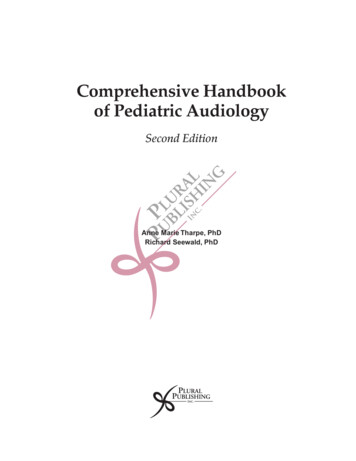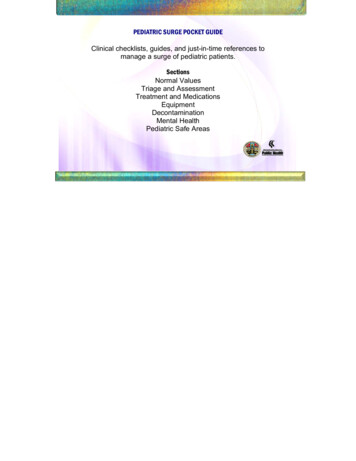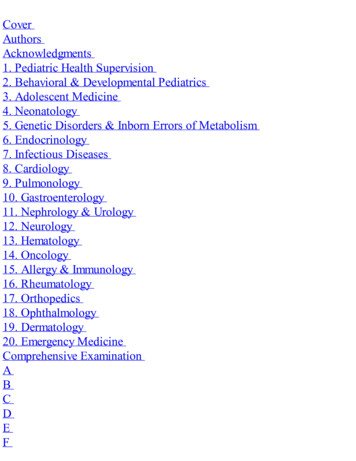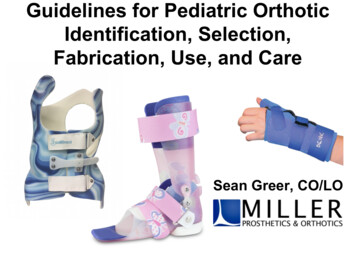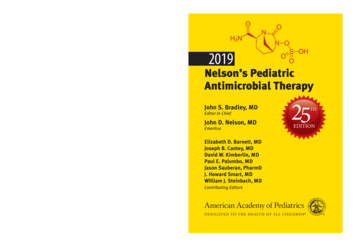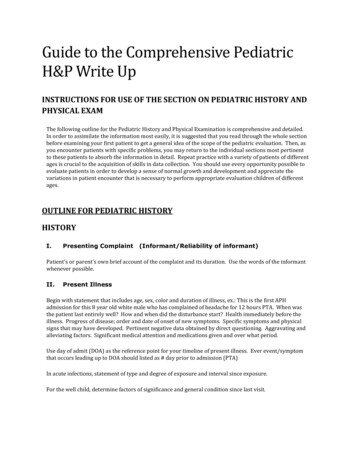
Transcription
Guide to the Comprehensive PediatricH&P Write UpINSTRUCTIONS FOR USE OF THE SECTION ON PEDIATRIC HISTORY ANDPHYSICAL EXAMThe following outline for the Pediatric History and Physical Examination is comprehensive and detailed.In order to assimilate the information most easily, it is suggested that you read through the whole sectionbefore examining your first patient to get a general idea of the scope of the pediatric evaluation. Then, asyou encounter patients with specific problems, you may return to the individual sections most pertinentto these patients to absorb the information in detail. Repeat practice with a variety of patients of differentages is crucial to the acquisition of skills in data collection. You should use every opportunity possible toevaluate patients in order to develop a sense of normal growth and development and appreciate thevariations in patient encounter that is necessary to perform appropriate evaluation children of differentages.OUTLINE FOR PEDIATRIC HISTORYHISTORYI.Presenting Complaint(Informant/Reliability of informant)Patient's or parent's own brief account of the complaint and its duration. Use the words of the informantwhenever possible.II.Present IllnessBegin with statement that includes age, sex, color and duration of illness, ex.: This is the first APHadmission for this 8 year old white male who has complained of headache for 12 hours PTA. When wasthe patient last entirely well? How and when did the disturbance start? Health immediately before theillness. Progress of disease; order and date of onset of new symptoms. Specific symptoms and physicalsigns that may have developed. Pertinent negative data obtained by direct questioning. Aggravating andalleviating factors. Significant medical attention and medications given and over what period.Use day of admit (DOA) as the reference point for your timeline of present illness. Ever event/symptomthat occurs leading up to DOA should listed as # day prior to admission (PTA)In acute infections, statement of type and degree of exposure and interval since exposure.For the well child, determine factors of significance and general condition since last visit.
III. Past Medical History BirthA. Antenatal: Health of mother during pregnancy. Medical supervision, drugs, diet, infections suchas rubella, etc., other illnesses, vomiting, toxemia, other complications; Rh typing and serology,pelvimetry, medications, x-ray procedure, maternal bleeding, mother's previous pregnancy history.B. Natal: Duration of pregnancy, birth weight, kind and duration of labor, type of delivery,presentation, sedation and anesthesia (if known), state of infant at birth, resuscitation required,onset of respiration, first cry.C. Neonatal: APGAR score; color, cyanosis, pallor, jaundice, cry, twitchings, excessive mucus,paralysis, convulsions, fever, hemorrhage, congenital abnormalities, birth injury. Difficulty insucking, rashes, excessive weight loss, feeding difficulties. You might discover a problem area byasking if baby went home from hospital with his mother.A common way to document birth history is as follows:3445 g full term infant born to a 28 yo G2P2 O mother via normal spontaneous vaginal deliveryafter a pregnancy where mother received prenatal care in the first trimester whose prenatal labswere GBS-, HIV-, GC-, chlamydia -, RPR nonreactive. Mom reports no medications taken duringpregnancy or delivery. Delivery was uncomplicated. No resuscitation was required. APGARs were8 at 1 min and 9 at 5 min. Nursery course was uncomplicated and infant went home with mom onDOL#2. Past IllnessesA comment should first be made relative to the child's previous general health, and then the specific areaslisted below should be explored.A.Past medical history: including all diagnoses, infections, Accidents and Injuries (includeingestions): Age, type/nature, severity, sequelae.B.Past Hospitalizations: including operations, age. Include place of hospitalization andduration of hospitalization.C.Past Surgeries: where and by whom for what diagnosisD.Allergies, with specific attention to drug allergies: detail type of reaction. Results of allergytesting gif performed.E.Medications patient is currently taking- prescribed, OTC, homeopathic. Include dose,formulation, route and frequency.
Immunizations and TestsBe familiar with Advisory Committee on Immunization Practices (ACIP) recommendations forimmunizations. List date and type of immunization, facility providing immunization as well as anycomplications or reactions. DO NOT LIST “Up to date per parent report” If no immunization record isavailable, include this as a problem in the assessment and plan so it will be followed up. Growth and DevelopmentA. Development Motor and Mental Development First raised head, rolled over, sat alone, pulled up, walkedwith help, walked alone, talked (meaningful words; sentences), formal screening whenappropriate. Urinary continence during night; during dayControl of feces. Comparison of development with that of siblings and parents. School grade, quality of work. Physical Growth including menarche and other pubertal developments Behavioral History Does child manifest any unusual behavior such as thumb sucking, excessive masturbation,severe and frequent temper tantrums, negativism, etc.? Sleep disturbances. Phobias. Pica (ingestions of substances other than food). Abnormal bowel habits, ex. - stool holding. Bed wetting (applicable only to child out of diapers). NutritionA. Breast or Formula: Type, duration, major formula changes, time of weaning, difficulties. Bespecific about how much milk or formula the baby receives. How does caretaker mix theformula?B. Vitamin Supplements: Type, when started, amount, duration.C. "Solid" Foods: When introduced, how taken, types.D. Appetite: Food likes and dislikes idiosyncrasies or allergies, reaction of child to eating. An ideaof child's usual daily intake is important.IV.Family History - use family tree whenever possibleA.B.Age and health of family members (parents, grandparents, siblings)Stillbirths, miscarriages, abortions; age at death and cause of death of immediate members offamilyC. Known genetic diseasesD. Diseases with a genetic contribution: allergy, blood dyscrasias, mental or nervous diseases,diabetes, cardiovascular diseases, kidney disease, rheumatic fever, neoplastic diseases,congenital abnormalities, cancer, convulsive disorders, othersE. Health of contacts- ill exposures (tuberculosis .)
V.Social HistoryA.B.C.D.VI.Type of habitat. Age of habitat, number of people in home and relationship to patientMarital status of parents and involvement with childParents employmentChild care or schoolEnvironmental HistoryA.B.C.D.E.Environmental tobacco smokeWater source to homePetsSmoke and CO detectorsFirearmsVII. System ReviewA system review will serve several purposes. It will often bring out symptoms or signs missed incollection of data about the present illness. It might direct the interviewer into questioning aboutother systems that have some indirect bearing on the present illness (ex. - eczema in a child withasthma). Finally, it serves as a screening device for uncovering symptoms, past or present, whichwere omitted in the earlier part of the interview. There is no need to repeat previously recordedinformation in writing a Review of Systems. Questions about health maintenance may be includedhere such as last dental visit, last ophthalmology visit A. General: Unusual weight gain or loss, fatigue, temperature sensitivity, mentality. Pattern of growth(record previous heights and weights on appropriate graphs). Time and pattern of pubescence.B. Eyes: Have the child's eyes ever been crossed? Any foreign body or infection, glasses for any reason.C. Ears, Nose and Throat: Frequent colds, sore throat, sneezing, stuffy nose, discharge, post-nasal drip,mouth breathing, snoring, otitis, hearing, adenitis.D. Teeth: Age of eruption of deciduous and permanent; number at one year; comparison with siblings.E. Cardiorespiratory: Frequency and nature of disturbances. Dyspnea, chest pain, cough, sputum, wheeze,expectoration, cyanosis, edema, syncope, tachycardia.F. Gastrointestinal: Vomiting, diarrhea, constipation, type of stools, abdominal pain or discomfort,jaundice.G. Genitourinary: Enuresis, dysuria, frequency, polyuria, pyuria, hematuria, character of stream, vaginaldischarge, menstrual history, bladder control, abnormalities of penis or testes. Details of menarche andmenstruation for adolescent femalesH. Neuromuscular: Headache, nervousness, dizziness, tingling, convulsions, habit spasms, ataxia, muscleor joint pains, postural deformities, exercise tolerance, gait.
I. Endocrine: Disturbances of growth, excessive fluid intake, polyphagia, goiter, thyroid disease.J. Hematologic: Bruise easily, difficulty stopping bleeds, lumps under arms, neck; fevers, shakes, shiversK. Rheumatologic: Joints: pain, stiffness, swollen, variation in joint pain during day, fingers painful/ blue incold, dry mouth, red eyes, back, neck painL. Skin: Ask about rashes, hives, problems with hair, skin texture or color, etc.OUTLINE FOR PEDIATRIC PHYSICAL EXAMPHYSICAL EXAMINATIONEvery child should receive a complete systematic examination at regular intervals. One should not restrictthe examination to those portions of the body considered to be involved on the basis of the presentingcomplaint.Approaching the ChildAdequate time should be spent in becoming acquainted with the child and allowing him/her to becomeacquainted with the examiner. The child should be treated as an individual whose feelings andsensibilities are well developed, and the examiner's conduct should be appropriate to the age of thechild. A friendly manner, quiet voice, and a slow and easy approach will help to facilitate the examination.Observation of the PatientAlthough the very young child may not be able to speak, one still may receive much information fromhim/her by being observant and receptive. The total evaluation of the child should include impressionsobtained from the time the child first enters until s/he leaves; it should not be based solely on the periodduring which the patient is on the examining table. In general, more information is obtained by carefulinspection than from any of the other methods of examination.Sequence of ExaminationSkill, tact and patience are required to gather an optimal amount of information when examining achild. There is no routine one can use and each examination should be individualized. Ham it up andregress. Get down to the child's level and try to gain his trust. The order of the exam should conform tothe age and temperament of the child. For example, many infants under 6 months are easily managed onthe examining table, but from 8 months to 3 years you will usually have more success substituting themother's lap. Certain parts of the exam can sometimes be done more easily with the child in the proneposition or held against the mother. After 4 years, they are often cooperative enough for you to performthe exam on the table again.Wash your hands with warm water before the examination begins. You will impress your patient'smother and not begin with an adverse reaction to cold hands in your patients. With the younger child, getto the heart, lungs and abdomen before crying starts. Save looking at the throat and ears for last. If part ofthe examination is uncomfortable or painful, tell the child in a warm, honest, but determined tone that thisis necessary. Looking for animals in their ears or listening to birdies in their chests is often another usefulapproach to the younger child.
If your bag of tricks is empty and you've become hoarse from singing and your lips can no longer bringforth a whistle, you may have to turn to muscle. Various techniques are used to restrain children andexperience will be your best ally in each type of situation.Remember that you must respect modesty in your patients, especially as they approachpubescence. Sometime during the examination, however, every part of the child must have beenundressed. It usually works out best to start with those areas which would least likely make your patientanxious and interfere with his developing confidence in you.General Physical ExaminationI. Vital Signs and MeasurementsTemperature, pulse rate, and respiratory rate (TPR); blood pressure (the cuff shouldcover 2/3 of the upper arm), weight, height, and head circumference. The weight shouldbe recorded at each visit; the height should be determined at monthly intervals duringthe first year, at 3-month intervals in the second year, and twice a year thereafter. Theheight, weight, and head circumference of the child should be compared with standardcharts and the approximate percentiles recorded. Multiple measurements at intervalsare of much greater value than single ones since they give information regarding thepattern of growth that cannot be determined by single measurements.II. General AppearanceDoes the child appear well or ill? Degree of prostration; degree of cooperation; state of comfort,nutrition, and consciousness; abnormalities, gait, posture, and coordination; estimate of intelligence;reaction to parents, physician, and examination; nature of cry and degree of activity, facies and facialexpression. Be as descriptive as possible in this section so that your patient “can be picked out of acrowd.”III. SkinColor (cyanosis, jaundice, pallor, erythema), texture, eruptions, hydration, edema, hemorrhagicmanifestations, scars, dilated vessels and direction of blood flow, hemangiomas, cafe-au-lait areasand nevi, Mongolian (blue-black) spots, pigmentation, turgor, elasticity, and subcutaneousnodules. Striae and wrinkling may indicate rapid weight gain or loss. Sensitivity, hair distributionand character, and desquamation. Be particularly careful in this section to describe your physicalexam findings instead of just listing a diagnosis. Also pay particular attention to details that willhelp determine progression or resolution of lesion at subsequent visits for example, size andlocation *Practical notes:A. Loss of turgor, especially of the calf muscles and skin over abdomen, is evidence ofdehydration.B. The soles and palms are often bluish and cold in early infancy; this is of no significance.C. The degree of anemia cannot be determined reliably by inspection, since pallor (evenin the newborn) may be normal and not due to anemia.
D. To demonstrate pitting edema in a child it may be necessary to exert prolongedpressure.E. A few small pigmented nevi are commonly found, particularly in older children.F. Spider nevi occur in about 1/6 children under 5 years of age and almost ½ of olderchildren.G. "Mongolian spots" (large, flat black or blue-black areas) are frequently present overthe lower back and buttocks; they have no pathologic significance.H. Cyanosis will not be evident unless at least 5 gm of reduced hemoglobin are present;therefore, it develops less easily in an anemic child.I. Carotenemic pigmentation is usually most prominent over the palms and soles andaround the nose, and spares the conjunctivas.IV. Lymph NodesLocation, size, sensitivity, mobility, consistency. One should routinely attempt to palpate occipital,preauricular, anterior cervical, posterior cervical, sub mandibular, submental, axillary, epitrochlear, andinguinal lymph nodes.*Practical notes:A. Enlargement of the lymph nodes occurs much more readily in children than in adults.B. Small inguinal lymph nodes are palpable in almost all healthy young children. Small,mobile, non-tender shotty nodes are commonly found in residue of previous infection.V. HeadSize, shape, circumference, asymmetry, cephalhematoma, bosses, craniotabes, control, molding, bruit,fontanel (size, tension, number, abnormally late or early closure), sutures, dilated veins, scalp, hair(texture, distribution, parasites), face, transillumination.*Practical notes:A. The head is measured at its greatest circumference; this is usually at the midforeheadanteriorly and around to the most prominent portion of the occiput posteriorly.B. Fontanel tension is best determined with the quiet child in the sitting position.C. Slight pulsations over the anterior fontanel may occur in normal infants.D. Although bruits may be heard over the temporal areas in normal children, thepossibility of an existing abnormality should not be overlooked.E. Craniotabes may be found in the normal newborn infant (especially the premature)and for the first 2-4 months.F. A positive Macewen's sign ("cracked pot" sound when skull is percussed with onefinger) may be present normally as long as the fontanel is open.
G. Transillumination of the skull can be performed by means of a flashlight with a spongerubber collar so that it forms a tight fit when held against the head.VI. FaceSymmetry, paralysis, distance between nose and mouth, distance between eyes, depth of nasolabial folds,bridge of nose, distribution of hair, size of mandible, swellings, hypertelorism, Chvostek's sign, tendernessover sinuses.VII. EyesPhotophobia, visual acuity, muscular control, nystagmus, Mongolian slant, Brushfield spots, epicanthicfolds, lacrimation, discharge, lids, exophthalmos or enophthalmos, conjunctivas; pupillary size, shape,reaction to light and accommodation; media (corneal opacities, cataracts), fundi, visual fields (in olderchildren). At 2-4 weeks an infant will follow light. By 3-4 months, coordinated eye movements should beseen.*Practical notes:A. The newborn infant will usually open his eyes if he/she is placed in the prone position,supported with one hand on the abdomen, and lifted over the examiner's head.B. Not infrequently, one pupil is normally larger than the other. This sometimes occursonly in bright or in subdued light.C. Examination of the fundi should be part of every complete physical examination,regardless of the age of the child; dilatation of pupils may be necessary for adequatevisualization.D. A mild degree of strabismus may be present during the first 6 months of life but shouldbe considered abnormal after that time.E. To test for strabismus in the very young or uncooperative child, note where a distantsource of light is reflected from the surface of the eyes; the reflection should be presenton corresponding portions of the two eyes.F. Small areas of capillary dilatation are commonly seen on the eyelids of normalnewborn infants.G. Most infants produce visible tears during the first few days of life but consistent tearproduction occurs after the first 4-6 weeks of life.VIII. NoseExterior, shape, mucosa, patency, discharge, bleeding, pressure over sinuses, flaring of nostrils, septum.At birth the maxillary antrum and anterior and posterior ethmoid cells are present. At 2-4 yearspneumatization of the frontal sinus takes place but is rarely a site of infection until the 6th - 10thyear. Though the sphenoid sinus is present at birth, it does not assume clinical significance until the 5th to8th year.
IX. MouthLips (thinness, down turning, fissures, color, cleft), teeth (number, position, caries, mottling, discoloration,notching, malocclusion or malalignment), mucosa (color, redness of Stensen's duct, enanthems, Bohn'snodules, Epstein's pearls), gum, palate, tongue, uvula, mouth breathing, geographic tongue (usuallynormal).X. ThroatTonsils (size, inflammation, exudate, crypts, inflammation of the anterior pillars), mucosa, hypertrophiclymphoid tissue, postnasal drip, epiglottis, voice (hoarseness, stridor, grunting, type of cry, speech). Thenumber and condition of the teeth should be recorded. (A child should have 20 teeth by age 2½years. When the teeth begin to erupt is quite variable but most infants have their two lower centralincisors by 8-10 months.A. Before examining a child's throat it is advisable to examine his mouth first. Permit thechild to handle the tongue blade, nasal speculum and flashlight so that he/she canovercome his fear of the instruments. Then ask the child to stick out his tongue and say"Ah" louder and louder. In some cases this may allow an adequate examination. Inothers, if the child is cooperative enough, he/she may be asked to "pant like a puppy;"while he/she is doing this, the tongue blade is applied firmly to the rear of thetongue. Gagging need not be elicited in order to obtain a satisfactory examination. Instill other cases, it may be expedient to examine one side of the tongue at a time, pushingthe base of the tongue to one side and then to the other. This may be less unpleasant andis less apt to cause gagging.B. Young children may have to be restrained to obtain an adequate examination of thethroat. Eliciting a gag reflex may be necessary if the oral pharynx is to be adequatelyseen.C. The small child's head may be restrained satisfactorily by having the mother place herhands at the level of the child's elbows while the arms are held firmly against the sides ofhis head.D. If the child can sit up, the mother is asked to hold him erect in her lap with his backagainst her chest. She then holds his left hand in her left hand and his right hand in herright hand, and places them against the child's groin or lower thighs to prevent him fromslipping down from her lap. If the throat is to be examined in natural light, the motherfaces the light. If artificial light and a head mirror are used, the mother sits with her backto the light. In either case, the physician uses one hand to hold the head in position andthe other to manipulate the tongue blade.E. Young children seldom complain of sore throat even in the presence of significantinfection of the pharynx and tonsils.XI. EarsPinnas (position, size), canals, tympanic membranes (landmarks, mobility, perforation, inflammation,discharge), mastoid tenderness and swelling, hearing (including hearing screen).
*Practical notes:A. A test for hearing is an important part of the physical examination of every infant.B. The ears of all sick children should be examined.C. Before actually examining the ears, it is often helpful to place the speculum just withinthe canal, remove it and place it lightly in the other ear, remove it again, and proceed inthis way from one ear to the other, gradually going farther and farther, until satisfactoryexamination is completed.D. In examining the ear, as large a speculum as possible should be used and should beinserted no farther than necessary, both to avoid discomfort and to avoid pushing wax infront of the speculum so that it obscures the field. The otoscope should be held balancedin the hand by holding the handle at the end nearest the speculum. One finger shouldrest against the head to prevent injury resulting from sudden movement by the child.E. The child may be restrained most easily if he/she is lying on his abdomen.F. Low-set ears are present in a number of congenital syndromes, including several thatare associated with mental retardation. The ears may be considered low-set if they arebelow a line drawn from the lateral angle of the eye and the external occipitalprotuberance.G. Congenital anomalies of the urinary tract are frequently associated with abnormalitiesof the pinnas.H. To examine the ears of an infant it is usually necessary to pull the auricle backwardand downward; in the older child the external ear is pulled backward and upward.XII. NeckPosition (torticollis, opisthotonos, inability to support head, mobility), swelling, thyroid (size, contour,bruit, isthmus, nodules, tenderness), lymph nodes, veins, position of trachea, sternocleidomastoid(swelling, shortening), webbing, edema, auscultation, movement, tonic neck reflex.*Practical notes:In the older child, the size and shape of the thyroid gland may be more clearly defined if thegland is palpated from behind.XIII. ThoraxShape and symmetry, veins, retractions and pulsations, beading, Harrison's groove, flaring of ribs, pigeonbreast, funnel shape, size and position of nipples, breasts, length of sternum, intercostal and substernalretraction, asymmetry, scapulas, clavicles.*Practical notes:At puberty, in normal children, one breast usually begins to develop before the other. Inboth sexes tenderness of the breasts is relatively common. Gynecomastia is notuncommon in the male.
XIV. LungsType of breathing, dyspnea, prolongation of expiration, cough, expansion, fremitus, flatness or dullness topercussion, resonance, breath and voice sounds, rales, wheezing.*Practical notes:A. Breath sounds in infants and children normally are more intense and more bronchial,and expiration is more prolonged, than in adults.B. Most of the young child's respiratory movement is produced by abdominal movement;there is very little intercostal motion.C. If one places the stethoscope over the mouth and subtracts the sounds heard by thisroute from the sounds heard through the chest wall, the difference usually represents theamount produced intrathoracically.XV. HeartLocation and intensity of apex beat, precordial bulging, pulsation of vessels, thrills, size, shape,auscultation (rate, rhythm, force, quality of sounds - compare with pulse as to rate and rhythm; frictionrub-variation with pressure), murmurs (location, position in cycle, intensity, pitch, effect of change ofposition, transmission, effect of exercise).*Practical notes:A. Many children normally have sinus arrhythmia. The child should be asked to take adeep breath to determine its effect on the rhythm.B. Extra systoles are not uncommon in childhood.C. The heart should be examined with the child recumbent.XVI. AbdomenSize and contour, visible peristalsis, respiratory movements, veins (distension, direction of flow),umbilicus, hernia, musculature, tenderness and rigidity, tympany, shifting dullness, tenderness, reboundtenderness, pulsation, palpable organs or masses (size, shape, position, mobility), fluid wave, reflexes,femoral pulsations, bowel sounds. If the liver is palpable below the right costal margin, its total span mustbe recorded. A deep abdomen palpation must be done on every child.*Practical notes:A. The abdomen may be examined while the child is lying prone in the mother's lap orheld over her shoulder, or seated on the examining table with his back to thedoctor. These positions may be particularly helpful where tenderness, rigidity, or a massmust be palpated. In the infant the examination may be aided by having the child suck ata "sugar tip" or nurse at a bottle.B. Light palpation, especially for the spleen, often will give more information than deep.C. Umbilical hernias are common during the first 2 years of life. They usually disappearspontaneously.
XVII. Male GenitaliaCircumcision, meatal opening, hypospadias, phimosis, adherent foreskin, size of testes, cryptorchidism,scrotum, hydrocele, hernia, pubertal changes.*Practical notes:A. In examining a suspected case of cryptorchidism, palpation for the testicles should bedone before the child has fully undressed or become chilled or had the cremasteric reflexstimulated. In some cases, examination while the child is in a hot bath may behelpful. The boy should also be examined while sitting in a chair holding his knees withhis heels on the seat; the increased intra-abdominal pressure may push the testes intothe scrotum.B. To examine for cryptorchidism, one should start above the inguinal canal and workdownward to prevent pushing the testes up into the canal or abdomen.C. In the obese body, the penis may be so obscured by as to appear abnormally small. Ifthis fat is pushed back, a penis of normal size is usually found.XVIII. Female GenitaliaVagina (imperforate, discharge, adhesions), hypertrophy of clitoris, pubertal changes.*Practical note:Digital or speculum examination is rarely done until after puberty.XIX. Rectum and AnusIrritation, fissures, prolapse, imperforate anus. The rectal examination should be performed with the littlefinger (inserted slowly). Note muscle tone, character of stool, masses, tenderness, sensation. Examinestool on glove finger (gross, microscopic, culture, guaiac), as indicated.XX. ExtremitiesA. General: Deformity, hemiatrophy, hemihypertrophy, bowlegs (common in infancy),knock-knees (common after age 2), paralysis, edema, coldness, posture, gait, stance,asymmetry.B. Joints: Swelling, redness, pain, limitation, tenderness, motion, rheumatic nodules,carrying angle of elbows, tibial torsion.C. Hands and feet: Extra digits, clubbing, simian lines, curvature of little finger, deformityof nails, splinter hemorrhages, flat feet (feet commonly appear flat during first 2 years),abnormalities of feet, dermatoglyphics, width of thumbs and big toes, syndactyly, lengthof various segments, dimpling of dorsa, temperature.D. Peripheral Vessels: Presence, absence or diminution of arterial pulses.XXI. Spine and BackPosture, curvatures, rigidity, webbed neck, spina bifida, pilonidal dimple or cyst, tufts of hair, mobility,Mongolian spots, tenderness over spine, pelvis or kidneys.
XXII. Neurologic ExaminationA. Cerebral Function: General behavior, level of consciousness, intelligence, emotionalstatus, memory, orientation, illusions, hallucinations, cortical sensory interpretation,cortical motor integration, ability to understand and communicate, auditory-verbal andvisual-verbal comprehension, recognition of visual object, speech, ability to write,performance of skilled motor acts.B. Cranial Nerves:1. I (olfactory) - Identify odors; disorders of smell2. II (optic) - Visual acuity, visual fields, ophthalmoscopic examination, retina.3. III (oculomotor), IV (trochlear), and VI (abducens) - Ocular movements,ptosis, dilatation of pupil, nystagmus, pupillary accommodation, and pupillarylight reflexes.4. V (trigeminal) - Sensation of face, corneal reflex, masseter and temporalmuscles, maxillary reflex (jaw jerk).5. VII (facial) - Wrinkle forehead, frown, smile, raise eyebrows, asymmetry offace, strength of eyelid muscles, taste on anterior portion of tongue.6. VIII (acoustic) a. Cochlear
The following outline for the Pediatric History and Physical Examination is comprehensive and detailed. In order to assimilate the information most easily, it is suggested that you read through the whole section before examining your first patient to get a general idea of the sco
